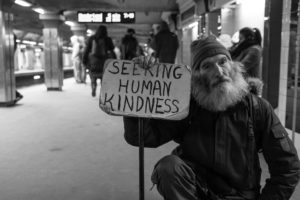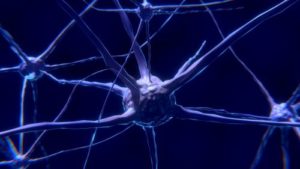
Investigating the effects and efficacy of self-compassion intervention on generalized anxiety disorders
Do you remember the dread of presenting in front of a crowd, or does even the thought make you uneasy? For some, anxiety is a
The Vitória Hotel in downtown Campinas, Brazil looks like any other high-class, modern establishment. Sunlight dances across the wide, turquoise pool. The white marble floor shines so brightly it almost looks reflective. Fresh, floral scents waft across the lobby.
Hendrée Jones, a psychologist who has traveled here from the United States, is standing in this swanky lobby, eyeing a large glass bowl of potpourri. She takes a few steps closer to examine the contents: brown star shapes with a sharp licorice scent and soft, fuzzy pine cones that smell like Christmas.
These will do. Jones scoops a few handfuls into a plastic bag.
“Don’t worry, I put it back later,” she says with a chuckle.
Jones pockets the baggy of potpourri and walks outside to hail a cab. After 45 minutes of winding through traffic, the cab drops Jones in a favela outside Campinas. Like so many impoverished areas of Brazil, the houses here are lit (sometimes) by illegal electricity while children run through the streets, zigzagging between enormous piles of trash.
Jones walks into the local drug treatment facility. She is here to manage a group therapy session for 35 children ranging in age from seven to 17. They sit in rows, classroom style.
These are not your average underprivileged kids—they have been used and abused by local drug lords. Some of these children started using drugs at age six. Some of them were handed guns at age seven. They are tough to the core yet they exist in a constant state of fear. Many of them are orphans and live on the street.
“What do you give to someone who has nothing?” Jones asks. “No home, no family, no purpose in life?”
What?
“The power of their own breath.”
Today she’ll be teaching this group mindfulness exercises.
“We focus on concentration,” Jones says. “So rather than sharpening your focus, which is what happens when you get anxious, the goal is to relax your focus.” The ability to utilize your breath to calm your nervous system is the first step to teaching mindfulness.
She slowly walks around the room and asks everyone, if they feel comfortable, to close their eyes. If they don’t feel comfortable closing their eyes, they can look down towards the floor with a soft gaze. Then she places a small object in their hands—this is where the borrowed potpourri comes in. The children wrap their fingers around the small shapes. Jones begins by asking simple questions: Is the object rough or smooth? Is it heavy or light? What does it smell like?
“They’re not answering outwardly,” Jones says. “We’re creating an inward dialogue designed to help them watch their own thoughts.” By asking them about all the different aspects of this object, Jones can focus their racing minds on something simple and peaceful.
For another exercise, Jones stands in front of the group, stretches her arms over her head, and starts rapidly tapping her own head.
“I put my hands on my head and make fast, quick motions to illustrate how we live in high vibrations of anxiety,” she explains. In the violent and unpredictable environments these children inhabit, stress and fear are constants. Racing thoughts, shallow breaths, and rapid heart rate are all signs of being prepared for a threat.
Jones slowly lowers her arms down to her sides to symbolize the act of mentally and physically slowing down.
“When we bring these kids into a treatment center, we work on physical safety as well as emotional safety,” she says. Without fearing for their physical safety, their heart rate lowers, and their breathing slows.
The breathing techniques focus on the repetition of inhales and exhales. The rhythmic sense of specific patterns helps slow everything down, which helps to calm the central nervous system.
“Fully using your lungs gets more oxygen to your brain and helps you think more clearly,” Jones says. “They can allow their thoughts to move in a more detached way, which helps them make better decisions.”
The breathing exercises are tailored to what the children can tolerate. “They’re scared,” Jones says. “They’re used to surveying for threats, and they’re typically not able to pay attention to anything for long.” Knowing that their attention spans and patience are limited, she starts the session off with a couple of easy belly breathing exercises.
To demonstrate, Jones lies down on the floor and places a small object, like a stuffed animal, on her stomach. As she breathes, the stuffed animal moves up and down. The children watch, and then imitate the exercise.
Another exercise creates a rhythmic breathing pattern through counting—breathe in for a count of four, hold it for a count of seven, and then breathe out for a count of eight. “That’s not one we would start with,” Jones says. “It takes a little more concentration, and a lot of times kids don’t have the patience for that—so we build up to it.”
In all her years of working with people who have been using drugs—both children and adults—Jones says the inability to feel is a constant. “They have a hard time feeling happy, and they have a hard time feeling sorrow,” she says. “They have great fear for feeling any type of emotion because when you take drugs, you numb everything—you can’t selectively numb out the sad or bad emotions, you numb out everything—the happiness as well as the sadness.”
And that’s what the breathing exercises and slowing the pace of the mind is all about. Learning how to sit with emotions, even those that are painful, and learning how to separate from them. As we so often hear in mindfulness trainings, the ability to respond thoughtfully instead of reacting automatically is a crucial skill.
“You have to learn how to be uncomfortable, and sit with it,” Jones says. “The more you can do that, the better off you are.”

ML is an international science communicator who has worked with the NSF, NASA, the NIH and more.

Do you remember the dread of presenting in front of a crowd, or does even the thought make you uneasy? For some, anxiety is a

“Self-compassion emerged as a crucial factor for mental toughness. Athletes who treated themselves with kindness and understanding were more confident, resilient, and capable of coping

“These results highlight that trauma-sensitive interventions could be combined with mindfulness and self-compassion interventions to address the unique presenting clinical problems of those who experienced

“The findings do support existing theories that link self-compassion to the ability to receive compassion from others, which is often fostered through secure attachment relationships.

This study investigates the impact of humane education on fostering empathy and compassion towards animals within the Indian adolescent population. It addresses the escalating concerns

“Fostering self-compassion and building strong support systems empowers educators and counselors to guide students through mental distress, enhancing their well-being and resilience.” This study investigated

“Even if they felt excluded, those who had greater levels of self-compassion exhibited less depression because they tended to use positive coping mechanisms. “

The study also highlighted how emotional well-being and self-compassion act as mediators, bridging the gap between mental toughness and aggression to strengthen the protective impact of mental toughness against aggression.

The research highlights the importance to encourage self-compassion and forgiveness to improve older people’s mental health

Recent studies investigating the relationship between loneliness and poor sleep quality in teenagers discovered a significant correlation between higher loneliness and poorer sleep quality.

By providing an immersive, engrossing, and controlled visual and auditory experience in which participants can practice mindfulness techniques, Virtual Reality (VR) systems can create immersive, ecologically valid, first-person experiences that can even tap into physiological reactions that align with real-world experiences.

The researchers were interested in understanding if forgiveness acts as a mechanism by which mindfulness relates to relationship satisfaction. They speculated that being mindful would allow individuals to be aware of their own and their partners’ emotions in a non-judgmental and non-reactive way. The increased awareness would make people more forgiving of partner transgressions, thereby enhancing relationship satisfaction.

Emerging studies are highlighting the effectiveness of mindfulness, gratitude and hopefulness as positive psychological tools in helping people cope with anxiety and stress. These practices have also been considered beneficial in enhancing psychological health and well-being.

Despite growing knowledge that mindfulness meditation can enhance emotional wellbeing, very little is known about how it all works. How exactly does the act of meditation help us deal with the emotional rollercoaster of everyday life? Is mindfulness training actually “transferrable” to real world situations? What’s going on in the brain? Can we even measure it?

How does self-compassion protect depressed adolescents? Quieting the self may be the key.

A study led by Alexandra Martelli investigated whether more mindful individuals (based on self-report measure scores) would respond to social rejection with less distress and if certain neurological mechanisms in the brain’s prefrontal cortex can potentially explain the role of mindfulness in reduced social distress.

A research team from Valencia, Spain recently investigated the effects of a brief mindfulness-based intervention on both mood and biological markers on a sample of health professional students.

A new study by Kim and colleagues explored how compassion-based training can affect two self-regulatory styles and its relationship to neural, physiological, and behavioral responses.

Torre and colleagues recruited 70 HCWs from two hospitals in Rome, Italy for a 4-week course in yoga and mindfulness.

A team of researchers based in the perceived epicenter of the virus, Wuhan, China, recently tested whether a brief mindfulness intervention delivered through an app could be effective for reducing anxiety and protecting nightly sleep during the unfolding pandemic.

Mindfulness practices can enhance a therapist’s ability to intentionally and flexibly regulate attention as well as emotional reactivity which has been demonstrated to influence burnout.

A new study investigated whether a brief mindfulness training designed to reduce physician burnout could be delivered through a smartphone app.

The current study reviewed the wider scientific literature for the role of yoga and mindfulness interventions in the treatment of severe mental illness.

The amount of research involving mindfulness interventions has grown exponentially; however, only in the last decade has mindfulness research involving adolescents rapidly increased.

Mindfulness and self-compassion are theorized to disrupt the maladaptive repetition of negative thoughts and emotions for patients with chronic or mental illnesses, who are particularly susceptible to psychosocial distress.

There is promising evidence that 70% of smokers would like to quit but less than 5% of unassisted attempts at quitting are actually successful.

In a recent pilot study by Suzette Glasner, Ph.D. and her team at the Integrated Substance Abuse Programs at the David Geffen School of Medicine at UCLA, they evaluated the effects of Mindfulness-Based Relapse Prevention (MBRP) on reducing relapse susceptibility among stimulant-dependent adults receiving a contingency management (CM) intervention.

A major implication of the study suggests the distal effects of intensive retreat practice on respiration rates, a benefit not necessarily conferred by a brief, but full-day meditation session.

Researchers are exploring mindfulness-based interventions as a long-term treatment options to address the multitude of symptoms after cancer has been treated.

While the scientific study of mindfulness has exponentially increased over the past few decades, only recently has the scientific community focused on the effects of meditation training on biological aging.
Tell us about your idea. Nearly any subject related to the science of mindfulness is fair game.